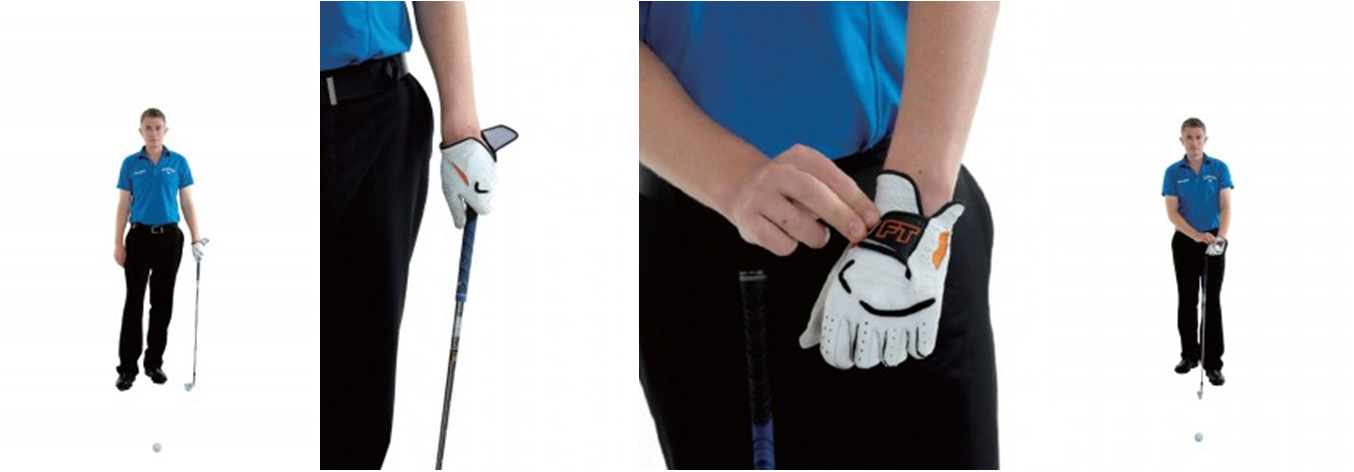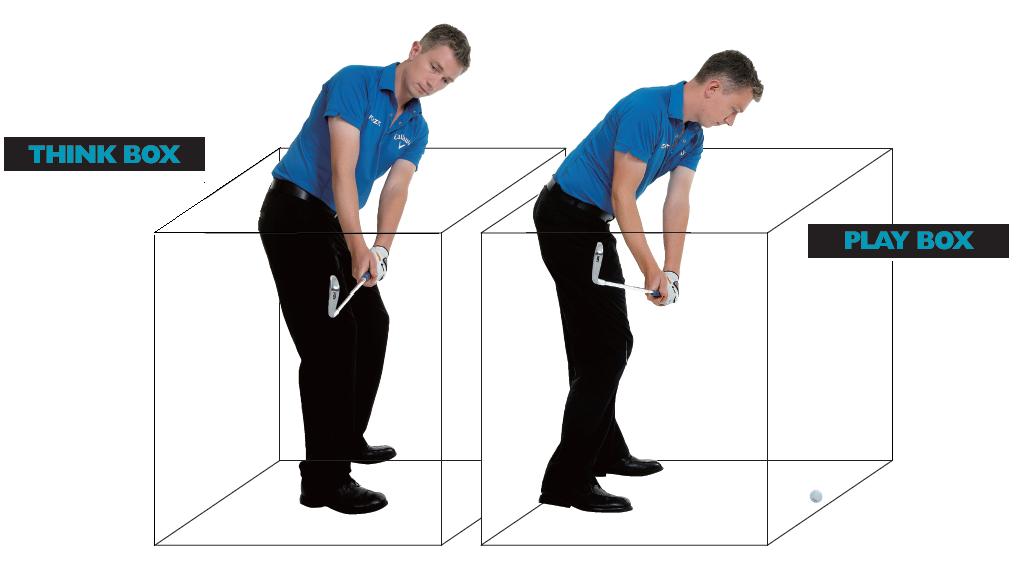Mental Golf – The Pre Shot Routine
Golf Lesson – Pre-Shot Routine
Recently, I looked at video footage of the 2 greatest players in the History of golf so far, Jack Nicklaus and Tiger Woods. If you look at them closely, many of the things they do vary a lot. Their golf swings are completely different in style, putting strokes different, even the way they address a chip shot looks different. Many would say that their pre-shot routines are different, as well. Jack Nicklaus standing over the ball for much longer with many more waggles than Tiger. There is no doubt in the differences, when you look at it like this, but there are 2 very important elements which make them similar.
1) How they both stare at the target with no thoughts other than where they want the ball to go.
2) The consistency of the timing of their routines.
I looked at videos of Jack in 1967, 1984 and 2009, and the amazing thing is that in a 42 year difference, the time from when he starts walking into the ball, to starting his backswing and to impact, is within 0.010 sec of a difference!
Another example is Tiger. You can start a watch at the moment he makes his first step into the ball, and with every club, the length of time walking into address, the time he starts his backswing and reaches the top of his backswing, and the time he makes impact is exactly the same time every time!
Great players do things differently, but it is almost super-natural how consistent their pre-shot routines are. If you want to be a champion, you must develop a consistent routine and practice it.
I cannot tell you exactly what routine you should use. As I have said, even Jack and Tiger are different, but the key point is it must be consistent. What I will do is give you a concept and make sure you understand all the elements that must be included in a good routine. From this, you can start designing your own personal routine. The important point is once you have your routine that includes all the elements below, you have to stick with it, practice it and make it yours!
Elements of a Pre-Shot Routine:
- Practice swings – How many? Where?
There are 3 places players normally take a practice swing:
1) Beside the ball. The benefit of this is once the practice swing is finished, the player can move to the ball with only a short time delay between their last practice swing and hitting the shot, making it easier to repeat the feeling of the practice swing and reducing time to over-think. The problem is it can be difficult to aim correctly with this method; your eyes are only ever looking side on to the target. I recommended this method if you have a problem of getting nervous, over thinking before a shot, or you are someone who stands at address for too long.
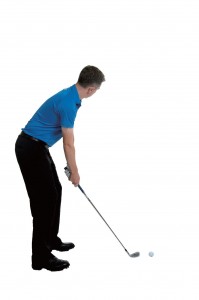
2) Behind the ball side on to the target. This is probably the most common place for practice swings. The benefit is it allows the player to take practice swings with their body aligned in the same direction as the target, gaining a good feeling for the shot they are about to play. Once they finish their practice swings, they can turn around and look directly down the target line to give them the best chance of aiming correctly. The negative is it can be a routine that takes a little more time. I would see this as the standard routine.
3) The last position is again behind the ball, but this time with the body aligned 90 degrees to the target. The benefit of this is it allows both eyes to look directly down the target line while taking practice swings; this is what I call “binocular vision” and normally makes alignment much easier. Once the practice swings are finished, the player can move quickly to the ball and hit the shot. The only problem is that when you are not making practice swings in the same direction as the target, it can make it more difficult to get a feeling for the shot. I would recommend this position for anyone who feels they need to improve their alignment when they are about to play. Once they finish their practice swings, they can turn around and look directly down the target line to give them the best chance of aiming correctly. The negative is it can be a routine that takes a little more time. I would see this as the standard routine.
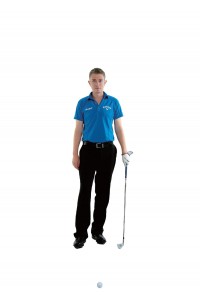 As you can see above, each position has positives and negatives. It is your individual choice, and your strengths and weaknesses. If there was one position much better than the others, everyone would be doing the same.
As you can see above, each position has positives and negatives. It is your individual choice, and your strengths and weaknesses. If there was one position much better than the others, everyone would be doing the same.
- Target awareness and how you aim – What’s your method?
This will depend a lot on where you took your practice swings. If you stand beside the ball, you have very little choice in how you will align yourself for the shot. It would be like if you were going to shoot a gun, and at a point before you fired the shot, placing yourself behind the barrel of the gun to look down the target line. You must trust your instinct and hit the shot with no doubt. If you have taken your practice swings from behind the ball, you have more of an opportunity of creating a method for aiming, because you have a clear look down the target line. Probably the most popular is visualizing a line between the ball and the target in your mind, and picking a spot in front of the ball about 12 inches. As you walk into the ball, you can keep your eye on this spot and align your clubface and body to this point. It is a lot easier to aim at something 12 inches in front of you rather than something 200 metres away! This will be the first step in aiming correctly, but the last step should be to look at the target for awareness of where you want to go. Don’t just look at the target, but stare at it, blocking out everything else.
- Over the ball – How many times do you look at the target? How long do you stand over the ball?
This will vary from player to player, but as I said before, the important thing is that it is consistent every time. Players who do not have a routine suffer under pressure. 1 look at the target can turn into 3 or 4 looks, 5 sec over the ball can turn into 15 sec. A short story on this topic was Choi NaYeon, in 2011. There was a point in the year that she was not playing her best and her results were not up to her normal standard. When I visited her at the British Open, we looked at some videos and saw that her routine had become about 3 sec slower than her normal. This gave her longer to think, and as a result, she did not make as positive a swing. That week, she got back to her old routine and back to her normal level of play! In my opinion, most top players do not stand over the ball any longer that 5 – 7 sec, so I want to encourage you to develop a routine that is short in time.
- The timing of the total routine – Consistency in timing of each area of the routine.
Maybe this is a little more advanced, but a good routine is not just consistent in the time standing over the ball, but also in the total time from when you have started to walk into the ball. Get a friend to time you and practice making your total time consistent.
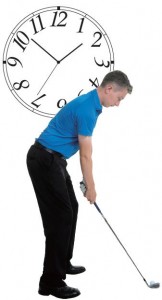
- Start and finish – Does your routine have a starting point and finishing point?
The idea to a start and finish to your routine is that you must be able to switch on and off your focus. Clearly you must be in a state of focus to hit a good shot, but also it is impossible to focus for 4-5 hrs with no break. Mental coaches will tell you that you need a trigger to start your routine – to put you in that focused state of mind. A bit like in soccer when the whistle blows to start the game and a whistle blows to finish. Just the sound of the whistle will put a soccer player in that focused state; it is a subconscious trigger. Some players use a trigger of tightening their glove to start their focus and untightening to finish their focus. Watch Tiger. You will see on the tee box when he is waiting, he will never tighten his glove until he is ready to start his pre-shot routine. Many top players do not even realize they have a trigger to start and finish their routine, but more often than not they have when you look carefully.
Concept
These are the elements that must be included in a routine, but I would like to also give you an overall concept. Again, everyone is different, so it is only a suggestion, but one I have had good success with it the past. I cannot take credit for this; I must give credit to the famous coaches of Anikia Sorenstam, Pia Nilsson and Lynn Marriott of Vision 54. The concept is called THINK BOX – PLAY BOX.
There is nothing worse for me than to see a student standing over the ball on the first tee for 20 sec changing their grip, practicing their move away, and thinking more about how to hit the ball rather than where to hit the ball!! This is where you need to understand the difference between THINKING and FEELING if you want to be able to turn your hard practice and improved swing into improved performance. Vision 54 believes in separating thinking and feeling and doing this by creating a THINK BOX and PLAY BOX in the Pre-Shot Routine.
Thinking
When you ask how to do something, this means you are THINKING about what you need to do. In certain situations, when you are learning a new movement, you will need to think.
Feeling
Developing feel for a movement is different from thinking. For example, your instructor holds your club and makes a movement for you or gives you a training aid to practice with, and this will give you the FEELING without thinking. I believe that great players can use FEELINGS when they are playing under tournament conditions, but never think during the shot. The concept is simple:
Think Box
Create a imagery box behind the ball where you do all your thinking – distance, uphill / downhill, wind, pin position, and club selection etc. You can even make some practice swings thinking about an aspect of your swing (a practice move away, tall posture etc). What you must do is finish your time in the think box with one full complete swing, turning your thinking into feeling.
Play Box
Create another imagery box around the ball. This is the play box. In this box, your only thoughts should be where you want the ball to go and playing with your feeling that you developed in the think box.

